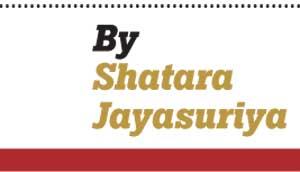Reply To:
Name - Reply Comment

They also maintained that there was no law under which the woman could have been arrested
He also said that the judge should have addressed the case judicially
The point about these laws like the Blasphemy laws in England is that it applies in a restrictive manner
Recently a Muslim woman was arrested for wearing a dress with a picture that apparently resembled the Dharmachakra- the wheel of dharma. Social media was abuzz criticizing the arrest as many believed that the picture was that of the helm of a ship. Amnesty International (South Asia) said that the absurdity of the purported ‘offense’ should be sufficient to release her  immediately and provide her with compensation. The statement on twitter further read that Amnesty International was shocked by the Sri Lankan authorities’ misuse of the ICCPR and the Penal Code provisions to detain people. The Daily Mirror spoke to a cross section of concerned parties who believed the arrest was part of the ongoing anti-muslim sentiments, that such an arrest, which amounts to harassment, has no place in Buddhism. They also maintained that there was no law under which the woman could have been arrested.
immediately and provide her with compensation. The statement on twitter further read that Amnesty International was shocked by the Sri Lankan authorities’ misuse of the ICCPR and the Penal Code provisions to detain people. The Daily Mirror spoke to a cross section of concerned parties who believed the arrest was part of the ongoing anti-muslim sentiments, that such an arrest, which amounts to harassment, has no place in Buddhism. They also maintained that there was no law under which the woman could have been arrested.
‘Picture resembled a Dharmachakra’
According to Police Media Spokesperson Ruwan Gunasekara the woman was arrested on the grounds that the picture on her dress ‘resembled’ a Dharmachakra. “Since there was a possibility of the incident leading to unrest with the people around, the woman was arrested. She was produced before courts and is in remand until the 27th of May,” he told the Daily Mirror.
When asked under which law the arrest was made, he said the Legal Director of the Police is to determine it. “We have informed the Director-Legal to check whether the picture is that of the Dharmachakra because it appears to be like some other picture too. We have informed him to examine the B report and make a decision,” he said.
“No offence criminalising the dress of the woman”
Meanwhile, Human Rights Lawyer, J.C.Weliamuna said that there was no offense that criminalised the dress of the woman concerned. “An arrest of a person must relate to an offence. What is the law here?” he quizzed.
“If this is to be an offence it should be specifically set out in the law,” he added. He pointed out that even if it was a picture of the Dharmachakra the question was whether it was prohibited to be worn on a dress?
According to him in most instances Section 291B of the Penal Code is used to file charges. Section 291B relates to deliberate and malicious acts intended to outrage religious feelings of any class, by insulting its religion or religious beliefs.
"He further added that Customs could issue guidelines against importing items with religious symbols; which may offend the religious sensibilities of a group of people"
“There should be a criminal intention. Say, you donate clothes with religious symbols such as the cross or the Dharmachakra to a beggar. Do you think the beggar should be arrested? Does he have an intention to insult a religion?” quizzed Weliamuna.
He further pointed out that Section 291B was a provision where Court cannot take cognizance unless the Attorney General’s Permission is given or the AG has allowed someone else to proceed with it.
“If someone did it purposely to attack Buddhism and the intention is clear, it is understandable (to have insulted a religion)” he said, adding that in the incident concerned there was no insult to Buddhism.
He also said that the judge should have addressed the case judicially.
“This is a knee jerk reaction to what is going on in the country. This is unfortunate,” he said.
“The law applies in a restrictive manner.”
Speaking to the Daily Mirror Chairperson of the Human Rights Commission (HRC) Dr. Deepika Udagama said that the Commission would follow up the incident with the Police.
“This is about how the law is interpreted. Where the law (on insulting religions as found in the Penal Code) is enforced it should be enforced regarding all religions. No religion must be insulted. The point about these laws like the Blasphemy laws in England is that it applies in a restrictive manner. There must be a sense in a plural society that everybody and all religions are protected. There should be a bigger discussion on blasphemy,” she said.
‘A practice to show loyalty to faith’
Meanwhile Sociologist Dr. Kumudu Kusum Kumara asserted that there should be a clear law stating that the particular symbols should not be worn over the body or on a dress. “The Dharmachakra is worn, among other symbols, in chains just like how the Christians wear the cross. This is a practice by which people show that they are loyal to their faith. It signifies their attachment to the religion,” he said.
"He further pointed out that Section 291B was a provision where Court cannot take cognizance unless the Attorney General’s Permission is given or the AG has allowed someone else to proceed with it"
He pointed out that that the picture concerned was obviously the wheel of a ship.
“We have to view this incident as one of targeting a Muslim person wrongfully perceived as consciously offending Buddhist religious sentiments. This is part of the widespread generalised anti-Muslim sentiments that have been simmering in the post Easter-bomb attacks that became evident in social media and surfaced in the attacks on Muslims in Gampaha and the North Western province,” he said.
He further added that Customs could issue guidelines against importing items with religious symbols; which may offend the religious sensibilities of a group of people.
‘This is not the teachings of Buddhism’
Meanwhile, Ven.Dhammananda Thera, Executive Director of the Walpola Rahula Institute for Buddhist Studies, said that harassing people based on a symbol- be it in a dress or slipper- is not Buddhism. “Even if the picture is that of the Dharmachakra arresting people based on wearing a dress with it is not Buddhism. The basic teaching in Buddhism in non-violence and not to hurt someone. Here we are hurting someone to protect Buddhism and in the meantime are destroying Buddhism,” he said.